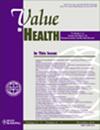How Many Monte Carlo Samples Are Needed for Probabilistic Cost-Effectiveness Analyses?
IF 6
2区 医学
Q1 ECONOMICS
引用次数: 0
Abstract
Objectives
Probabilistic sensitivity analysis (PSA) is conducted to account for the uncertainty in cost and effect of decision options under consideration. PSA involves obtaining a large sample of input parameter values () to estimate the expected cost and effect of each alternative in the presence of parameter uncertainty. When the analysis involves using stochastic models (eg, individual-level models), the model is further replicated times for each sampled parameter set. We study how and should be determined.
Methods
We show that PSA could be structured such that can be an arbitrary number (say, ). To determine , we derive a formula based on Chebyshev’s inequality such that the error in estimating the incremental cost-effectiveness ratio (ICER) of alternatives (or equivalently, the willingness-to-pay value at which the optimal decision option changes) is within a desired level of accuracy. We described 2 methods to confirm, visually and quantitatively, that the informed by this method results in ICER estimates within the specified level of accuracy.
Results
When is arbitrarily selected, the estimated ICERs could be substantially different from the true ICER (even as increases), which could lead to misleading conclusions. Using a simple resource allocation model, we demonstrate that the proposed approach can minimize the potential for this error.
Conclusions
The number of parameter samples in probabilistic cost-effectiveness analyses should not be arbitrarily selected. We describe 3 methods to ensure that enough parameter samples are used in probabilistic cost-effectiveness analyses.
概率成本效益分析需要多少蒙特卡罗样本?
目的:进行概率敏感性分析(PSA)是为了考虑所考虑的决策方案在成本和效果方面的不确定性。概率敏感性分析包括获取大量输入参数值样本(N),以估算在参数不确定的情况下每个备选方案的预期成本和效果。如果分析涉及使用随机模型(如个人层面的模型),则要对每个抽样参数集进行 P 次模型复制。我们将研究如何确定 N 和 P:我们表明,PSA 的结构可以使 P 成为一个任意数(例如,P=1)。为了确定 N,我们根据切比雪夫不等式推导出一个公式,使替代方案的增量成本效益比(ICER)(或等同于最优决策方案发生变化时的支付意愿值)的估算误差在所需的准确度范围内。我们介绍了两种方法,以直观和定量的方式确认这种方法所告知的 N 会导致 ICER 估计值在指定的准确度范围内:当 N 被任意选择时,估算的 ICER 可能与真实的 ICER 相差甚远(甚至随着 P 的增加),这可能导致误导性结论。通过使用一个简单的资源分配模型,我们证明了所提出的方法可以最大限度地减少这种误差的可能性:概率 CEA 中的参数样本数量不应随意选择。我们介绍了三种确保在概率 CEA 中使用足够参数样本的方法。
本文章由计算机程序翻译,如有差异,请以英文原文为准。
求助全文
约1分钟内获得全文
求助全文
来源期刊

Value in Health
医学-卫生保健
CiteScore
6.90
自引率
6.70%
发文量
3064
审稿时长
3-8 weeks
期刊介绍:
Value in Health contains original research articles for pharmacoeconomics, health economics, and outcomes research (clinical, economic, and patient-reported outcomes/preference-based research), as well as conceptual and health policy articles that provide valuable information for health care decision-makers as well as the research community. As the official journal of ISPOR, Value in Health provides a forum for researchers, as well as health care decision-makers to translate outcomes research into health care decisions.
 求助内容:
求助内容: 应助结果提醒方式:
应助结果提醒方式:


